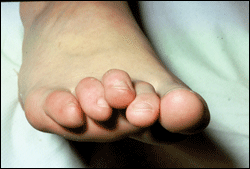
Metatarsalgia
A general term describing “a pain in the ball of the foot” (metatarsal heads). It is usually created by excessive, unnatural pressure to the metatarsal heads causing inflammation. Symptoms may include: aching; burning; swelling; calluses and corns. Diseases, trauma, poor quality footwear, aging and hard surfaces must be considered when treating this problem. Pain relief is usually achieved with proper chiropodial care and shoe modifications.
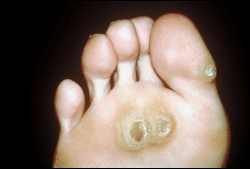
Calluses/Corns
The body’s defense response to abnormal friction or pressure to the skin. This is usually caused by foot deformities; improper footwear; or postural imbalances of the foot. Corns may develop at the location where the pressure or stress is excessive. They are often painful and may become infected. A biomechanical assessment to determine the cause and chiropodial treatments are required to control or resolve these lesions.
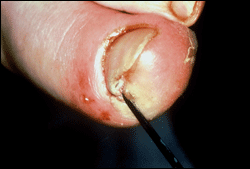
Ingrown Toenails
A common, painful condition usually affecting the big toe or second toe. It is often caused by poor nail cutting techniques; nail deformities i.e.: curling at the edges; improper footwear or poor hygiene. Persons who develop “ingrowing” nails or painful nails should seek assistance from a Chiropodist to determine its cause and to treat/resolve the problem. Diabetes and persons with poor circulation are susceptible to serious infection and should seek help immediately to prevent further complications. Occasionally, permanent nail surgery may be required.
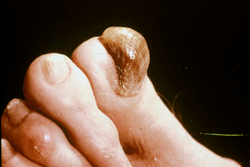
Thick Toe Nails
Abnormally thick nails may occur due to trauma; aging, diseases i.e. diabetes, poor circulation, etc. They are often too difficult for people to cut themselves. Chiropodial treatments can reduce the thickness, usually painlessly and therefore reduce the likelihood or further complications.
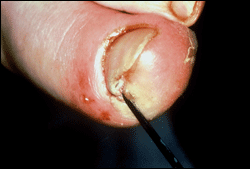
Involuted Nails
Involuted nails are toenails that curve inwards on one or both sides of the nail. They may become very painful or infected as the nail bed is often pinched causing a reduction of blood flow. Chiropodial assessments and treatments are necessary to determine their cause and to control/eliminate associated pain or infections. Chiropodial treatments are usually painless.
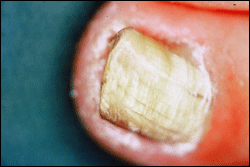
Fungal Nails
A nail that has developed a fungal infection (onychomycosis). The nail will usually develop white; brown or yellow streaks and if left untreated will cause deformity of the nail plate and spread into the remaining toe nails. A chiropodial evaluation can help to determine the appropriate course of treatment.
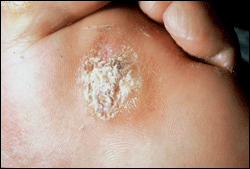
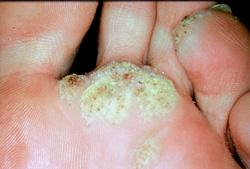
Plantar Warts
They are a viral infection which may enter the skin through cuts or cracks. Plantar warts occur on the feet and often grow inwards due to pressure from walking or standing. They usually enlarge, multiply and become painful if left untreated because we walk on them. They look “spongy”, have a cauliflower appearance, and often have “black spots” that represent broken microscopic blood vessels (capillaries); often thought to be roots (there are no roots!). Sometimes they can be mistaken as calluses or corns. A Chiropodial assessment should be considered to determine the best course of treatment i.e. acids, liquid nitrogen or a prescribed cream.
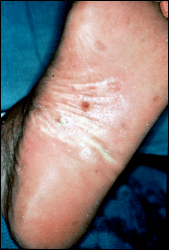
Athletes Foot/Fungus of the Skin
An infection of the skin caused by various types of fungus. Symptoms ranges from mild scaling and itching to painful inflammation and blistering. It often will develop between the toes usually the baby toe area or in the arches and may spread to the bottom and sides of the foot. It is often mistaken for “dry skin”. A chiropodial evaluation is required to determine the origin of cause and appropriate treatment. Athletes Foot may eventually spread to the toe nails if left untreated.
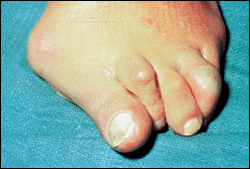
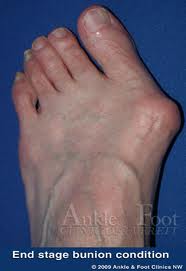
Bunions (Hallux Valgus)
Is a common deformity of the foot affecting the big toe area. They may become very painful if a persons footwear creates abnormal pressure. Bunions are often inherited and more common with women than men. Persons with bunions or believe they are developing bunions should have a biomechanical examination to determine appropriate forms of treatment. Options may include: education; proper fitting footwear; footwear modifications; orthotics; or surgery if conservative treatments do not control or reduce pain.
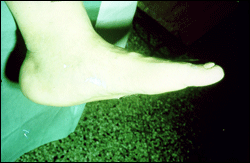
Flat Feet (Pes Planus)
These are feet with little or no medial longitudinal arches. Approximately 30% of adults have flat feet. Commonly they develop due to loose or stretchy ligaments (the wires that connect our bones together) and may cause symptoms of sore, tired, aching feet, legs, knees, hips or spine. If a person is concerned about their flat feet, they should have a biomechanical assessment. Many people do not have any complaints with their flat feet and they usually do not require treatment. Those who do suffer with pain, etc. may benefit from the use of better shoes, arch supports or orthotics.
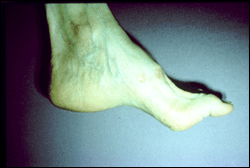
High Arches (Pes Cavus)
Feet that have high medial longitudinal arches. Approximately 13% of the population has this foot type. Unfortunately most high arch people will develop foot or foot related problems due to its inability to deal with the mechanical shock associated with foot strike to hard flat surfaces. Persons with high arches should have a biomechanical assessment to learn how to prevent or resolve/control painful symptoms if they develop. Shock absorbing footwear and soft orthotics are often necessary to control symptoms.
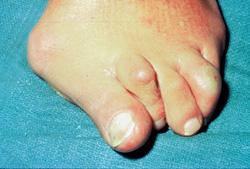
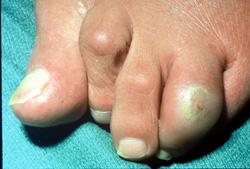
Hammer Toes
A condition where the toes are drawn up towards the ball of the foot. This forces the metatarsal head downwards towards the ground. This will often cause pressure lesions i.e. calluses/corns on the top of the toes (if they rub against the shoe toebox) or on the ball of the foot if excessive friction occurs. If symptoms develop, relief of pain can be achieved by internal shoe modifications; protective padding; chiropodial treatments; and/or orthotics.
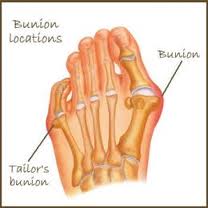
Tailor’s Bunion
Is a potentially painful swelling of the joint at the base of the baby toe area. It usually occurs with bunions. A biomechanical assessment can determine its cause and methods to resolve associated pain.
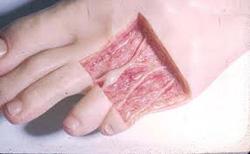
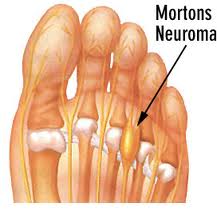
Mortons Neuroma (Plantar Digital Neuritis)
Symptoms of burning or aching often occur between the third and fourth toes. Pain develops when the nerve that runs between the metatarsal bones is compressed when standing or walking. A biomechanical assessment to determine the cause is essential to relieve pain. Narrow shoes often cause this condition.
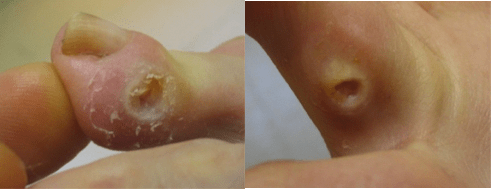
Soft Corn (Heloma Molle)
Occurs between two toes as a result of abnormal shearing stress and friction. Chiropodial treatments will relieve symptoms and proper fitting shoes, shoe modifications or orthotics may be required to control or resolve this condition.
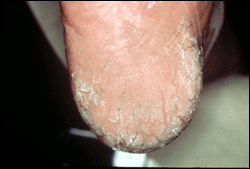
Painful Heels
Heels may become painful for numerous reasons. Shoes that are worn out or poorly fitted are often the main cause of callus with cracks/fissures and blisters on the back of the heel, or bursitis at the attachment of the Achilles tendon to the calcaneus (heel bone). Other painful heel conditions include: Achilles Tendonitis; Heel Spurs, Haglund’s Deformity (pump bumps) and Plantar Fasciitis. A biomechanical evaluation is often necessary to determine the cause of painful heels and to provide a treatment plan to resolve/control it.
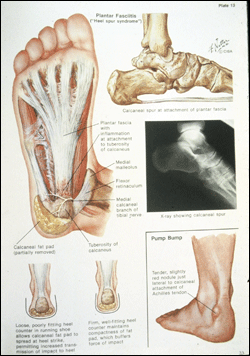
Plantar Fasciitis
Is a very common problem involving the bottom surface of the heel and the long arch. Pain usually begins as a dull ache and may progress to a sharp persistent ache. Often it is worse in the morning when a person rises out of bed or upon standing after sitting. The plantar fascia is a ligament that helps to form the medial longitudinal arch and it becomes inflamed due to abnormal or excessive stress created during heel strike when walking, running or standing. Swelling occurs deep inside the heel which causes pressure on the nerves in the region causing minor to severe pain while weight bearing.
There are many reasons that cause a person to develop plantar fasciitis including: aging; excessive body weight; flat feet; high arches; poor quality or worn out shoes. A biomechanical examination is important to determine the cause of this condition so that proper treatment can occur to resolve this debilitating problems.
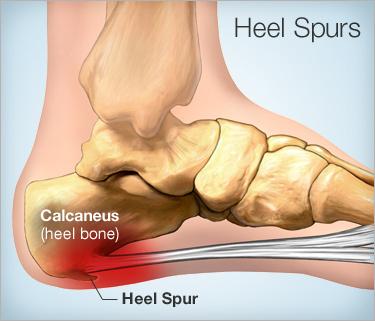
Heel Spurs
Are created by deposits of bone-like calcium on the heel bone at the insertion of the plantar fascia to the heel bone (calcaneus). It often develops as a result of a tear of the plantar fascia ligament near the front of the heel bone. The body lays down the calcium to strengthen the bond of the plantar fascia or to reattach it if a tear occurs. Spurs usually do not cause pain in this situation. Pain is usually caused by the inflammation associated with plantar fasciitis. A biomechanical assessment and possibly x-rays may be needed to determine the proper treatment options to control/resolve the pain.